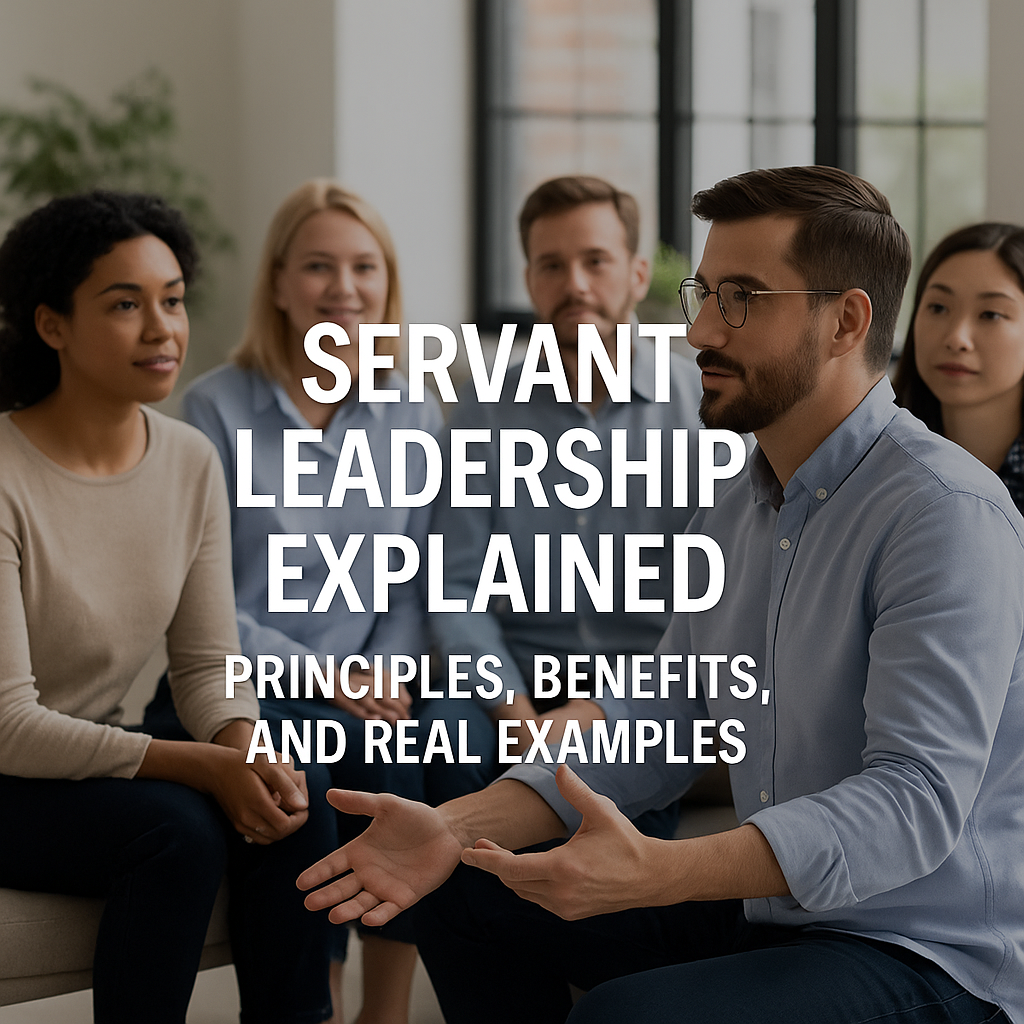What Is Servant Leadership?
Servant leadership is a philosophy where the leader’s primary role is to serve others. Unlike traditional leadership models that emphasize hierarchy and control, servant leadership puts the focus on the growth and well-being of people and the communities to which they belong. It’s about shifting from “power over” to “power with” — empowering team members and elevating them to reach their full potential.
This concept was first articulated by Robert K. Greenleaf in his landmark 1970 essay, The Servant as Leader. Greenleaf argued that the best leaders are those who are first servants — people who genuinely want to help others before they aspire to lead. Leadership then becomes a natural extension of that service.
Servant leadership has since grown into a respected model embraced by organizations seeking long-term cultural transformation, trust-based leadership, and sustainable performance.
The Principles Behind Servant Leadership
At the heart of servant leadership are 10 core principles that distinguish it from conventional models:
- Listening — Active, empathetic listening is foundational. Leaders must seek first to understand, then to be understood.
- Empathy — Servant leaders strive to feel what their team feels, offering compassion over judgment.
- Healing — Acknowledging that organizations are made of people, this principle speaks to a leader’s role in fostering emotional and spiritual health.
- Awareness — Self-awareness and situational awareness equip leaders to respond wisely, not react impulsively.
- Persuasion — Unlike command-and-control leaders, servant leaders rely on influence, not authority, to guide decisions.
- Conceptualization — They can look beyond daily tasks to the broader mission, vision, and values of the organization.
- Foresight — Drawing on the past and present to anticipate consequences of decisions before they’re made.
- Stewardship — Leaders act as caretakers of the resources, culture, and trust placed in their hands.
- Commitment to the Growth of People — Servant leaders believe in the intrinsic value of every individual and invest in their personal and professional development.
- Building Community — They cultivate an environment of trust, collaboration, and belonging, not just productivity.
These aren’t simply ideals to aspire to; they are practical skills and habits that build resilient, engaged teams. Organizations that adopt servant leadership often experience lower turnover, stronger culture, and higher long-term productivity.
Benefits of Servant Leadership in Practice
Servant leadership is often misunderstood as “soft” or passive, but research and case studies show the opposite. It is a proactive, human-centered approach that delivers tangible benefits:
- Increased Trust and Engagement: Employees who feel genuinely valued by leadership are more likely to be engaged, productive, and loyal.
- Enhanced Innovation: A culture of psychological safety allows teams to take risks, suggest bold ideas, and learn from failure.
- Better Collaboration: Servant-led teams typically demonstrate higher levels of cooperation and lower incidences of conflict.
- Sustainable Growth: By focusing on people rather than short-term metrics, servant leadership helps build organizations that last.
A study from the Journal of Business Ethics found that servant leadership not only improves job satisfaction but also boosts organizational citizenship behaviors — the kind of voluntary effort that drives high-performing cultures.
Real Examples of Servant Leadership
Herb Kelleher – Co-Founder, Southwest Airlines
Kelleher famously prioritized employee well-being above all else, believing that happy employees would naturally lead to satisfied customers. His leadership style helped shape Southwest’s reputation for loyalty and excellent customer service.
Cheryl Bachelder – Former CEO, Popeyes Louisiana Kitchen
Bachelder turned around a struggling company by focusing on franchisee support rather than top-down control. She emphasized accountability, service, and clarity of purpose, ultimately driving strong business performance.
Satya Nadella – CEO, Microsoft
When Nadella took the helm at Microsoft, he led a cultural transformation built around empathy, growth mindset, and inclusion. His human-first leadership style reinvigorated Microsoft’s brand and employee engagement.
These examples illustrate that servant leadership isn’t about relinquishing power — it’s about channeling power to elevate others.
How to Practice Servant Leadership in Daily Work
You don’t need to be a CEO to be a servant leader. Here are small ways to integrate its principles into your daily leadership:
- Start meetings by listening. Give everyone a chance to speak before you do.
- Coach, don’t dictate. Guide your team to find their own answers instead of solving everything yourself.
- Ask, “How can I support you?” Regularly check in on how your team is doing personally and professionally.
- Share the spotlight. Celebrate team wins and credit others publicly.
- Model humility. Acknowledge your own growth areas and invite feedback.
Servant leadership begins with intention. Over time, consistent small behaviors can transform a team’s culture and effectiveness.
Final Thoughts
Servant leadership flips the traditional leadership script by making service, not authority, the central goal. When done authentically, it creates thriving workplaces where individuals feel valued and empowered, and where business results follow naturally.
In today’s fast-moving, human-centered economy, the ability to lead with empathy, humility, and purpose isn’t just admirable—it’s essential.
Whether you’re leading a global enterprise or managing a small team, integrating servant leadership principles can foster trust, deepen engagement, and build something more enduring than any quarterly metric: a legacy of growth through service.




